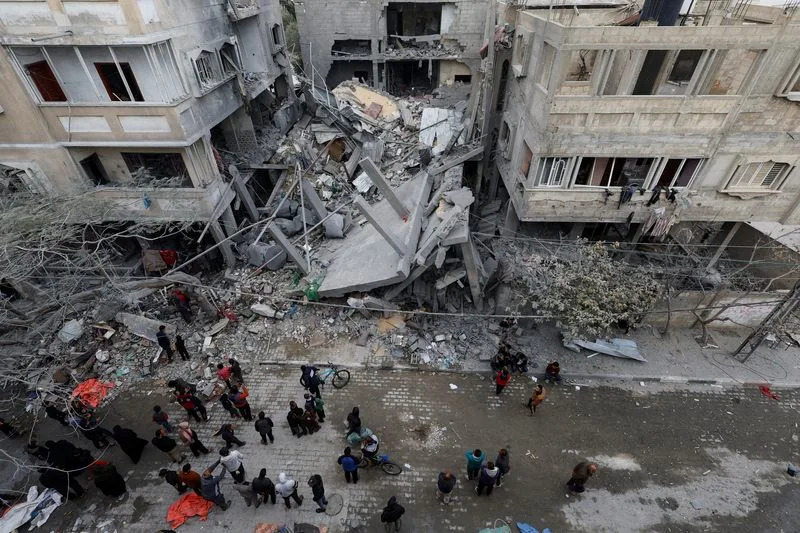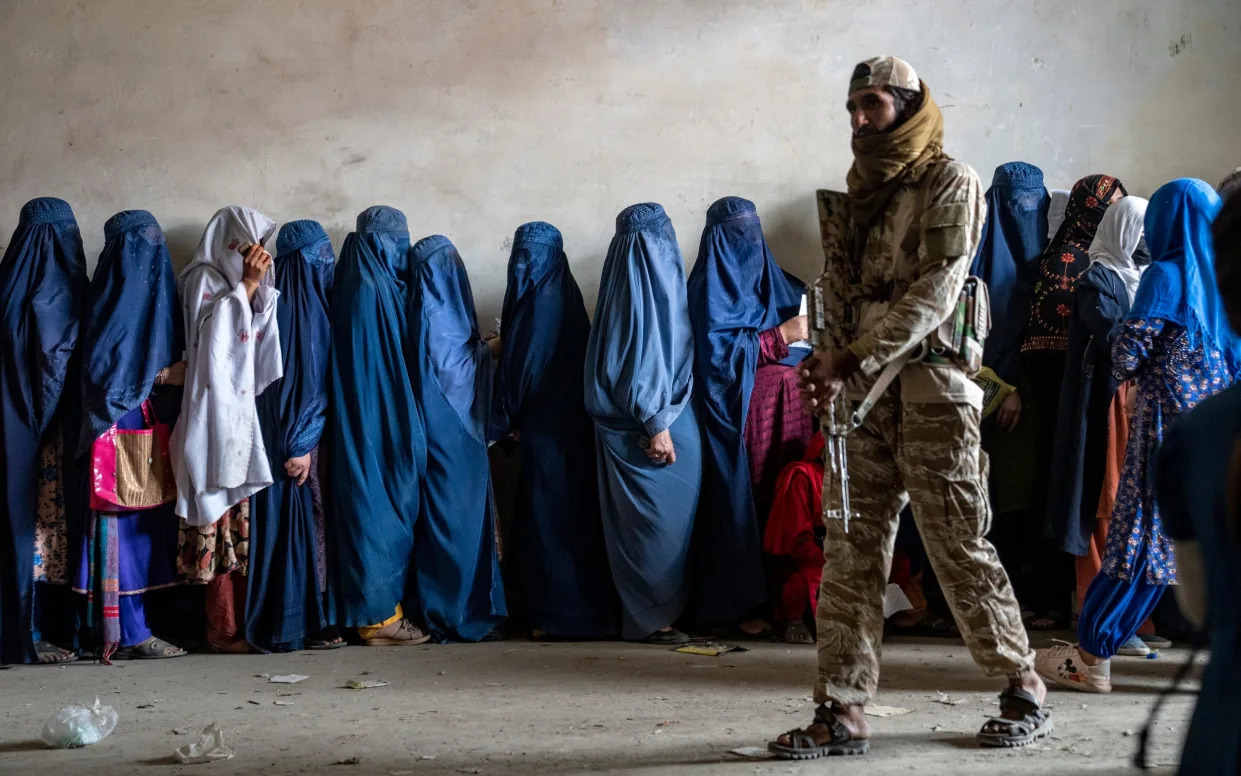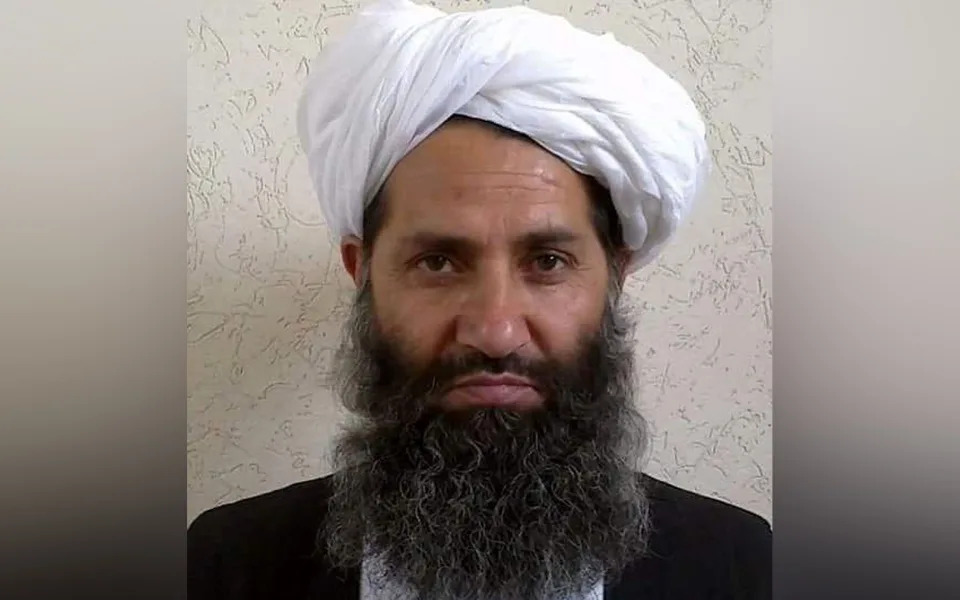John Davison, Michelle Nichols, Emma Farge, Emily Rose and Farah Saafan
Mon, March 25, 2024







CAIRO (Reuters) - In mid-March, a line of trucks stretched for 3 kilometers along a desert road near a crossing point from Israel into the Gaza Strip. On the same day, another line of trucks, some 1.5 kilometers long, sometimes two or three across, was backed up near a crossing from Egypt into Gaza.
The trucks were filled with aid, much of it food, for the more than 2 million Palestinians in the war-ravaged enclave. About 50 kilometers from Gaza, more aid trucks – some 2,400 in total – were sitting idle this month in the Egyptian city of Al Arish, according to an Egyptian Red Crescent official.
These motionless food-filled trucks, the main lifeline for Gazans, are at the heart of the escalating humanitarian crisis gripping the enclave. More than five months into Israel’s war with Hamas, a report by a global authority on food security has warned that famine is imminent in parts of Gaza, as more than three-quarters of the population have been forced from their homes and swathes of the territory are in ruins.
Galvanized by reports and images of starving children, the international community, led by the United States, has been pressuring Israel to facilitate the transfer of more aid into Gaza. Washington has airdropped food into the Mediterranean enclave and recently announced it would build a pier off the Gaza coast to help ferry in more aid.
U.N. officials have accused Israel of blocking humanitarian supplies to Gaza. The European Union’s foreign policy chief alleged Israel was using starvation as a “weapon of war.” And aid agency officials say Israeli red tape is slowing the flow of trucks carrying food supplies.
Israeli officials reject these accusations and say they have increased aid access to Gaza. Israel isn’t responsible for delays in aid getting into Gaza, they say, and the delivery of aid once inside the territory is the responsibility of the U.N. and humanitarian agencies. Israel has also accused Hamas of stealing aid.
Reuters interviewed more than two dozen people, including humanitarian workers, Israeli military officials and truck drivers, in tracing the tortuous route that aid takes into Gaza in an effort to identify the chokepoints and reasons for delays of supplies. Reuters also reviewed U.N. and Israeli military statistics on aid shipments, as well as satellite images of the border crossing areas, which revealed the long lines of trucks.
Before the aid shipments enter Gaza, they undergo a series of Israeli checks, and a shipment approved at one stage of the process can later be rejected, according to 18 aid workers and U.N. officials involved in the aid effort. At one crossing from Israel into Gaza, goods are twice loaded off trucks and then reloaded onto other trucks that then carry the aid to warehouses in Gaza. The aid delivery process can also be complicated by competing international demands, with some countries wanting their contributions to be prioritized.
Aid that does make it into Gaza can be ransacked by desperate civilians, sometimes fall prey to armed gangs, or get held up by Israeli army checkpoints. Half the warehouses storing aid in Gaza are no longer operational after having been hit in the fighting.
“It’s upsetting watching these aid trucks go nowhere and vast humanitarian supplies sit in warehouses when you think about what’s happening, right now, to the people who need them,” said Paolo Pezzati, an Oxfam worker who recently visited the queue of aid trucks near the Egypt-Gaza border.
Before the war began, an average of 200 trucks carrying aid entered Gaza each day, according to U.N. figures. A further 300 trucks laden with commercial imports, including food, agricultural supplies and industrial materials, also entered each day via Israel. Since the start of the war, an average of around 100 trucks have entered Gaza daily, according to a review of U.N. and Israeli military statistics on aid shipments.
While the trucks struggle to get into Gaza, the need for aid has risen dramatically, both because of the vast number of displaced people and the devastation of key infrastructure in Israel’s assault. This includes the destruction of bakeries, markets, and farmland whose crops met some of Gaza’s food needs.
“Previous wars weren’t like this,” said Alaa al-Atar, a municipal official, referring to conflicts in Gaza. “There wasn’t the destruction of all sources of subsistence – homes, farmland, infrastructure. There’s nothing left to survive on, just aid,” said Atar, who was displaced from the north to the south of Gaza early in the war.
To meet its minimum needs, aid agencies and U.N. officials say Gaza currently requires 500 to 600 trucks a day, including humanitarian aid and the commercial supplies that were coming in before the war. That’s about four times the number of trucks getting in now.
In March there has been an uptick, with an average of 150 trucks entering Gaza each day.
Some deliveries are being made by international air drops and via sea, but they aren't making up for shortfalls on the land routes. In the first three weeks of March, the equivalent of some 50 truckloads of aid was airdropped and brought in by sea, a Reuters tally based on Israeli military statistics showed.
The recent food security report, known as the Integrated Food Security Phase Classification (IPC), found that a lack of aid means almost all households in Gaza are skipping meals every day and adults are cutting back on meals so their children can eat. The situation is particularly dire in northern Gaza, it said, where in nearly two-thirds of households, “people went entire days and nights without eating at least 10 times in the last 30 days.”
The war was triggered by a Hamas-led attack on communities in southern Israel on Oct. 7 that killed 1,200 people and resulted in more than 250 being taken hostage, according to Israel. Since then, Israel’s assault on Gaza has killed more than 31,000 people, according to Gaza health authorities.
A senior Hamas official said Israel is responsible for the inadequate aid flows. The “biggest threat” to the distribution of aid is Israel’s ongoing attacks in Gaza, Hamas official Bassem Naim told Reuters. “The biggest obstacle to getting the aid to the people who need it is the continued gunfire and the continued targeting of aid and those who are handling it,” he said.
WAITING IN THE DESERT
Before some of the aid begins its journey to Gaza, it is flown to Cairo or shipped by sea to Port Said, which borders Egypt’s Sinai Peninsula, about 150 kms to the west of Al Arish. From there, it is trucked to the city of Al Arish, on the Mediterranean coast. Some aid is also flown directly to the Egyptian city.
Once in Cairo or Al Arish, the aid undergoes its first check. International agencies submit a detailed inventory of each shipment to the Israeli military via the U.N. for clearance. Israel has long banned “dual use” items that it says could be used by Hamas to make weapons.
Of 153 requests made to the Israeli authorities for goods to enter Gaza between Jan. 11 and March 15, 100 were cleared, 15 were rejected outright and another 38 were pending, the United Nations Office for the Coordination of Humanitarian Affairs told Reuters. U.N. officials didn’t specify whether a request referred to a specific number of trucks or volume of aid. It takes almost a month on average to get a response, according to minutes of a meeting of aid agencies seen by Reuters.
The Israeli military says it approves almost 99% of the Gaza-bound trucks it inspects and that once the goods are inside the enclave, it is the responsibility of the international aid organizations to distribute it. The inspection process “isn’t the impediment” to aid “getting into the Gaza Strip,” said Shimon Freedman, a spokesman for COGAT, the Israeli military branch that handles aid transfers.
Diplomatic wrangling by countries donating aid can also create snarls in the delivery process. U.N. officials told Reuters that because aid comes not only from international agencies but also directly from individual donor countries, the process of deciding which trucks go to the front of the queue can be thorny even before they depart Al Arish.
The Egyptian Red Crescent official said donor countries “drop off aid in Al Arish or at Al Arish airport and walk away and say, ‘We gave out aid to Gaza.’” It is the Red Crescent and Egyptian authorities who then bear the responsibility of getting the aid to Gaza, he said.
From Al Arish, the trucks make the 50-kilometer journey to the Rafah crossing point on the Egypt-Gaza border.
Next stop: Israel’s truck-scanning centers.
Once they reach the Rafah crossing, some trucks are then required to drive along the Egypt-Israel border for 40 kilometers to an inspection facility on the Israeli side called Nitzana. Here the goods are physically checked by Israeli soldiers who use scanning machines and sniffer dogs, according to U.N. and other aid agency staff.
Some items get rejected during the physical inspection, in particular ones Israel believes could be used by Hamas and other armed groups for military purposes. Some shipments carrying dual-use items are sent back to Al Arish. The same item that is let through one day, can be rejected on another day, U.N. officials and aid workers said.
U.N. agencies say solar panels, metal tent poles, oxygen tanks, generators and water purification equipment are among the items the military has rejected.
Pezzati, the Oxfam worker, said he saw a warehouse in Al Arish in early March that was filled with items banned by Israel. “There were crutches, camping toilets, hygiene kits, disinfectants for doctors, for surgery,” he said.
COGAT’S Freedman said there is a publicized list of what constitutes dual-use items, but there isn’t a “blanket ban” on these goods. If Israeli authorities “understand what exactly it is necessary for, we can coordinate it,” he said. But Israel wants to be sure that goods aren’t going to be “used by Hamas for terrorist activities,” he said.
Israel’s inspections, Freedman said, aren’t the reason for any backlog in aid. “We have the capacity to inspect more humanitarian aid than the international organizations can distribute,” he said.
The Israeli military says it can scan a total of 44 trucks an hour at Nitzana and at a crossing from Israel into Gaza where aid trucks are inspected, at Kerem Shalom. But aid agency officials say the actual number scanned is fewer. The military declined to say how many hours Nitzana and Kerem Shalom are open each day.
Once the trucks pass inspection at Nitzana, they make the 40-kilometer journey back to Rafah, where they wait to cross into Gaza.
In late January, groups of Israelis, including friends and relatives of the more than 130 people still being held hostage by Hamas, began protesting against the delivery of aid to Gaza. Between late January and early March, the protests effectively shut down either Nitzana or Kerem Shalom for a total of 16 days, according to aid agencies.
At the Kerem Shalom crossing, goods are unloaded from the scanned trucks and reloaded onto trucks that have been vetted by the Israeli army, according to U.N. and aid agency workers. These “sanitized” trucks then make a 1 kilometer journey to a warehouse inside Gaza where the aid is again offloaded. The goods are then placed on trucks driven by Palestinians and taken to mostly U.N.-run warehouses in Rafah.
Under growing international pressure, Israel earlier this month initiated a new route for the delivery of aid directly to northern Gaza, known as the 96th gate. By March 20, COGAT said at least 86 international aid trucks had entered via the new crossing.
“There is a sufficient amount of food entering Gaza every day,” said Col. Moshe Tetro, a COGAT official overseeing Gaza.
The new route was initiated “as part of a pilot in order to prevent Hamas from taking over the aid,” COGAT said in a post on social media site X. Freedman, though, said he didn’t have “specific evidence” he could share about Hamas pilfering aid.
Hamas official Naim rejected the accusation that the group was stealing aid. “We have been cooperating and are cooperating with every single state and humanitarian organization so that the aid reaches people in dire need,” he said.
AN ARDUOUS JOURNEY
Once inside Gaza, the aid shipments face more challenges.
Several convoys have been attacked on the stretch of road from Kerem Shalom to Gaza warehouses by people carrying crude weapons such as axes and box-cutters, according to U.N. officials and truck drivers. Deeper inside Gaza, others have been swarmed by crowds of people desperate for food.
In an incident that galvanized aid efforts, more than 100 people were killed in late February when a crowd descended on an aid convoy organized by Israel.
Security for food convoys traveling the short distance from the crossing points to warehouses in Rafah also deteriorated after several strikes by the Israeli military killed at least eight policemen in Gaza, according to U.N. officials. Israel says all police are members of Hamas.
“Whether they’re Hamas or not I don’t know, but they were doing a job for us in terms of crowd control,” said Jamie McGoldrick, a senior U.N. official. “The police are less willing to do that now.”
Aid agencies mostly now negotiate their own security with local communities, McGoldrick said.
Reuters reported recently that armed and masked men from an array of clans and factions in Gaza had begun providing security to aid convoys.
Police officers in Gaza “are Hamas, they are part of the Hamas terrorist organization,” COGAT’s Freedman said. Israel doesn’t target humanitarian convoys, “we try to assist them, but Hamas is our enemy.”
Storing aid in Gaza has also become a problem. Warehouses have been damaged by the fighting and occasionally looted. Of the 43 warehouses in Gaza that were operational before the war, only 22 are now working, according to the Logistics Cluster, a U.N.-run logistics facilitator for aid agencies.
In mid-March, an Israeli airstrike hit a U.N. food distribution center in southern Gaza, killing several people. Israel said it killed a Hamas commander in the attack. Hamas said the man targeted by Israel was a member of its police force.
From the warehouses, aid is delivered to southern Gaza, where the majority of the population is now located.
Making deliveries to northern Gaza is more fraught.
Roads to the north have been bombed by Israel and there are delays as trucks are held up or denied access at Israeli army checkpoints, say U.N. and other aid agency officials. Aid convoys are also often looted before reaching their destination by crowds of people desperate for food, U.N. officials said.
U.N. officials told Reuters that humanitarian agencies had made 158 requests to the Israeli military to deliver aid to northern Gaza from the beginning of the war to March 14. Of those, the military denied 57, they said.
COGAT’s Freedman said some requests to move aid inside Gaza have been rejected because aid agencies didn’t coordinate sufficiently with Israel.
“They weren't able to tell us exactly where that aid was going,” he said. “And if we don't know where it's going to, we don't know it's not going to end up in the hands of Hamas.”
In southern Gaza, residents are desperately waiting for aid.
“People have nothing to eat at all, nor do they have a place to stay, or a refuge,” said Suleiman al-Jaal, a local truck driver who said he has been attacked transporting aid in Gaza. “This is not a life. No matter how much aid they bring in, it’s not enough.”
AFP
Mon, March 25, 2024

Mutliple foreign nations have resorted to airdropping aid into Gaza, with the humanitarian situation increasingly dire (-)
A military plane banked over the war-ravaged ruins of Gaza City dropping dozens of black parachutes carrying food aid.
On the ground, where almost no building within sight was still standing, hungry men and boys raced towards the beach where most of the aid seemed to have landed.
Dozens of them jostled intensely to get to the food, with scrums forming up and down the rubble-strewn dunes.
"People are dying just to get a can of tuna," said Mohamad al-Sabaawi, carrying an almost empty bag on his shoulder, a young boy beside him.
"The situation is tragic, as if we are in a famine. What can we do? They mock us by giving us a small can of tuna."
Aid groups say only a fraction of the supplies required to meet basic humanitarian needs have arrived in Gaza since October, while the UN has warned of famine in the north of the territory by May without urgent intervention.
The aid entering the Gaza Strip by land is far below pre-war levels, at around 150 vehicles a day compared to at least 500 before the war, according to UNRWA, the UN agency for Palestinian refugees.
With Gazans increasingly desperate, foreign governments have turned to airdrops, in particular in the hard-to-reach northern parts of the territory including Gaza City.
The United States, France and Jordan are among several countries conducting airdrops to people living within the ruins of what was the besieged territory's biggest city.
But the aircrews themselves told AFP that the drops were insufficient.
US Air Force Lieutenant Colonel Jeremy Anderson noted earlier this month that what they were able to deliver was only a "drop in the bucket" of what was needed.
The air operation has also been marred by deaths. Five people on the ground were killed by one drop and 10 others injured after parachutes malfunctioned, according to a medic in Gaza.
Calls have mounted for Israel to allow in more aid overland, while Israel has blamed the UN and UNRWA for not distributing aid in Gaza.
"Palestinians in Gaza desperately need what has been promised -- a flood of aid. Not trickles. Not drops," UN chief Antonio Guterres said on Sunday after visiting Gaza's southern border crossing with Egypt at Rafah.
"Looking at Gaza, it almost appears that the four horsemen of war, famine, conquest and death are galloping across it," he added.
The war was sparked by Hamas's unprecedented October 7 attack on Israel, which resulted in about 1,160 deaths in Israel, mostly civilians, according to an AFP tally of official Israeli figures.
Israel launched a retaliatory bombardment and invasion of Gaza aimed at destroying Hamas that has killed at least 32,333 people, according to the health ministry in Hamas-run Gaza.
Returning home in Gaza City with little to keep his family going, Sabaawi said their situation was miserable.
"We are the people of Gaza, waiting for aid drops, willing to die to get a can of beans -- which we then share among 18 people."
bur-fg/jm/dcp
Israel besieges two more Gaza hospitals, demands evacuations, Palestinians say
Nidal al-Mughrabi





By Nidal al-Mughrabi
CAIRO (Reuters) -Israeli forces besieged two more Gaza hospitals on Sunday, pinning down medical teams under heavy gunfire, the Palestinian Red Crescent said, and Israel said it had captured 480 militants in continued clashes at Gaza's main Al Shifa hospital.
Israel says hospitals in the Palestinian enclave, where war has been raging for over five months, are used by Hamas militants as bases. It has released videos and pictures supporting the claim.
Hamas and medical staff deny the accusations.
The Palestinian Red Crescent said one of its staff was killed when Israeli tanks suddenly pushed back into areas around Al-Amal and Nasser hospitals in the southern city of Khan Younis, amid heavy bombardment and gunfire.
Israeli forces began operating around Al-Amal, the military said, following "precise intelligence ... which indicated that terrorists are using civilian infrastructure for terror activities in the area of Al-Amal."
Israeli armoured forces sealed off Al-Amal Hospital and carried out extensive bulldozing operations in its vicinity, the Red Crescent said in a statement.
"All of our teams are in extreme danger at the moment and are completely immobilised," it said.
The Red Crescent said Israeli forces were now demanding the complete evacuation of staff, patients and displaced people from Al Amal's premises and were firing smoke bombs into the area to force out its occupants.
A displaced Palestinian was killed inside the hospital compound after being hit in the head by Israeli fire, the Red Crescent said in a later update.
The health ministry in Hamas-run Gaza said dozens of patients and medical staffers had been detained by Israeli forces at Al Shifa in Gaza City in the enclave's north that has been under Israeli control for a week.
The Hamas-run government media office said Israeli forces had killed five Palestinian doctors during their seven-day-old swoop on Al Shifa.
The Israeli military did not immediately respond to a request for comment on that report. It said earlier that it had killed over 170 gunmen in the raid, which the Palestinian Health Ministry said had also caused the deaths of five patients.
Al Shifa is one of the few healthcare facilities even partially operational in north Gaza, and - like others - had also been housing some of the nearly 2 million civilians - over 80% of Gaza's population - displaced by the war.
"Right now, Hamas and Islamic Jihad terrorists are barricading themselves inside Shifa hospital wards," said Israeli military spokesperson, Rear Admiral Daniel Hagari.
Hagari said Hamas gunmen were firing at soldiers from inside the emergency and maternity wards of the hospital, and also firing mortars at troops in the hospital, causing damage.
The Hamas-run government media office said they "categorically refute this."
"How can they claim this while their soldiers roam and frolic inside the complex with ease, conducting interrogations with displaced persons, patients, and the wounded," said media office director Ismail Al-Thawabta.
AIR STRIKE KILLS SEVEN IN RAFAH
Reuters has been unable to access Gaza's contested hospital areas and verify accounts by either side.
Khan Younis residents said Israeli forces had also advanced and formed a cordon around Nasser Hospital in the city's west under cover of heavy air and ground fire.
In Rafah, Gaza's southernmost town on the Egyptian border that has become the last refuge for half of Gaza's uprooted population, an Israeli air strike on a house killed seven people, health officials said.
At least 32,226 Palestinians have been killed, among them 84 in the past 24 hours, and 74,518 injured in Israel's air and ground offensive into the densely populated coastal territory since Oct. 7, its health ministry said in a Sunday update.
Israel launched the offensive after Hamas-led Islamist militants attacked its south on Oct. 7, killing 1,200 people and taking 253 hostages back to Gaza, according to Israeli tallies.
U.S.-backed mediation by Qatar and Egypt has so far failed to secure a Hamas-Israel ceasefire, prisoner releases and unfettered aid to Gaza civilians facing famine, with each side sticking to core demands.
Hamas wants any truce deal to include an Israeli commitment to end the war and withdraw forces from Gaza. Israel has ruled this out, saying it will keep fighting until Hamas is eradicated as a political and military force.
U.N. Secretary-General Antonio Guterres described the backlog of aid destined for Gaza as a moral outrage during a visit to the Egyptian side of the Rafah border crossing on Saturday.
Speaking in Cairo on Sunday, Guterres said the only effective and efficient way to deliver heavy goods to meet Gaza's humanitarian needs was by road.
The United States and other countries have tried using air drops and ships to deliver aid, but U.N. aid officials say deliveries can only be scaled up by land, accusing Israel of impeding relief, which Israel denies.
(Reporting by Nidal al-Mughrabi and Emily Rose; editing by Mark Heinrich, Tomasz Janowski and Marguerita Choy)


